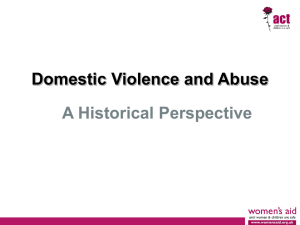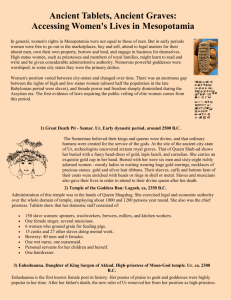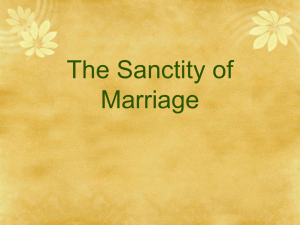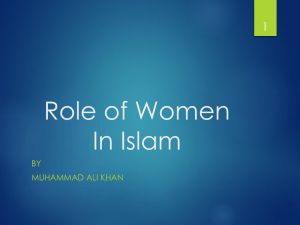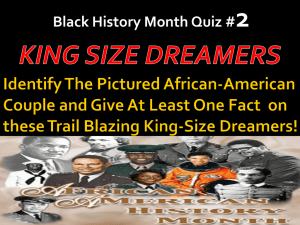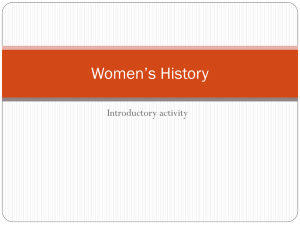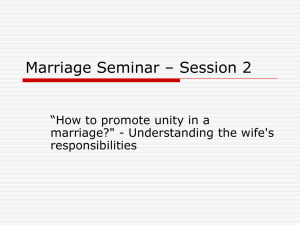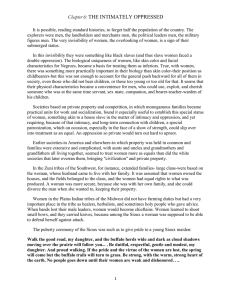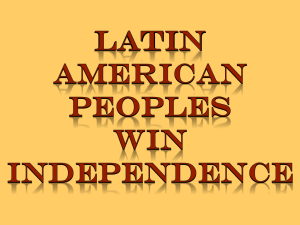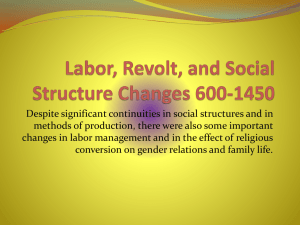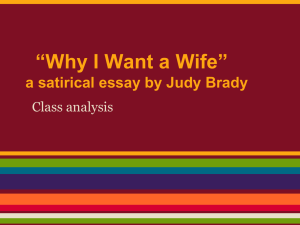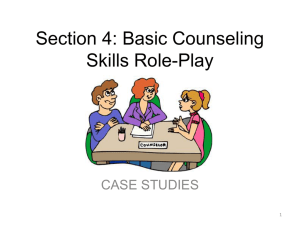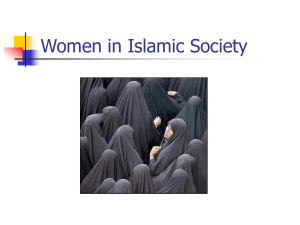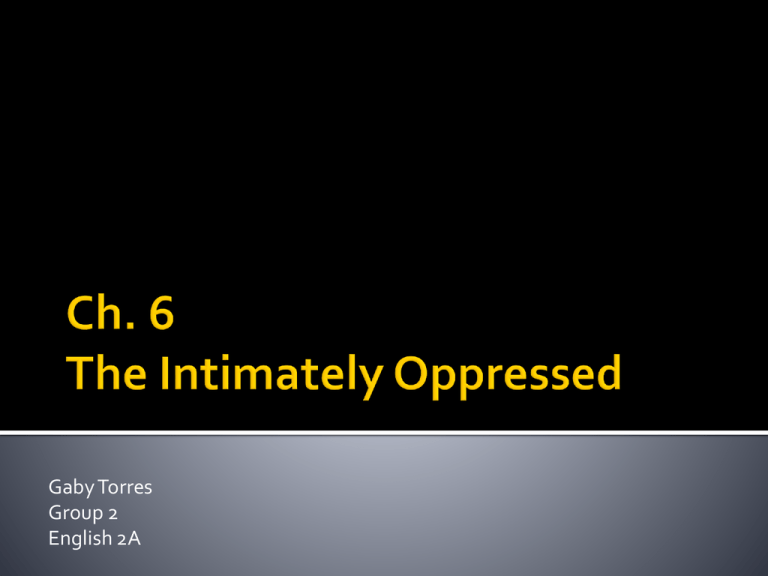
Gaby Torres
Group 2
English 2A
The Intimately Oppressed describes
resistance to inequalities in the lives of
women in the early years of the U.S. Howard
Zinn tells the stories of women who resisted
the existing state of affairs.
The very invisibility and overlooking of women, is a sign of men’s
status to dominate.
The biological uniqueness of women, like skin color and facial
characteristics for Negroes, became a basis for treating them as
inferiors.
More important than a women’s skin-color was their position as
child bearers.
However women’s physical characteristics became a convenience
for men, who could use, exploit, and cherish someone who was also
their servant, sex mate, companion, and bearer-teacher-warden of
his children.
Societies based on this, where monogamous
families became practical units for work and
socialization, found it especially useful to establish
this special status of women.
This status was something similar to a house slave
in the matter of intimacy and oppression, and yet
requiring a special patronization, which on occasion,
could slip over into treatment as an equal.
In America and elsewhere-in which property
was held in common and families were wide
spread and complicated, with everyone living
together, seemed to treat women more as
equals than did the white societies that later
invaded them, bringing "civilization" and
private property.
Extended families or large clans-were based on the
woman, whose husband came to live with her
family.
Assumed that women owned the houses, and the
fields belonged to the clans, and the women had
equal rights to what was produced.
A woman was more secure, because she was with
her own family, and she could divorce the man when
she wanted to, keeping their property.
Did not have farming duties
They had a very important place in the tribe as
healers, herbalists, and sometimes holy people
who gave advice.
When bands lost their male leaders, women
would become chieftains.
Women were not treated as equal as men but
they were treated with respect, and the
shared nature of the society gave them a
more important place.
Women were imported as sex slaves, child
bearers, and companions. Were abused by
Masters
Came as indentured servants- often teenaged
girls-and lived lives not much different from slaves
Their situation:
were poorly paid and often treated rudely and harshly,
deprived of good food and privacy.
had one primary path of resistance open to them:
passive resistance, trying to do as little work as possible
and to create difficulties for their masters and
mistresses
Elizabeth Sprigs: “am laboring almost Day
and Night,” “tied up and whipped to,”
“almost naked no shoes nor stockings to wear
... what rest we can get is to rap ourselves up
in a Blanket and lie upon the Ground…”
“Whatever horrors can be imagined in the
transport of black slaves to America must be
multiplied for black women”
Slave traders: I saw pregnant women give birth to
babies while chained to corpses
Linda Brent-escaped from slavery- My master met me
at every turn, reminding me that I belonged to him,
and swearing by heaven and earth that he would
compel me to submit to him.
Eighteen married women came over on the
Mayflower. Childbirth and sickness plagued the
women. By the spring, only four of those eighteen
women were still alive.
During the colonial period, Julia Spruill described: ''The
husband's control over the wife's person extended to the
right of giving her chastisement. . .. But he was not
entitled to inflict permanent injury or death on his wife. . “
Property: "Besides absolute possession of his wife's
personal property and a life estate in her lands, the
husband took any other income that might be hers. He
collected wages earned by her labor. . . . Naturally it
followed that the proceeds of the joint labor of husband
and wife belonged to the husband."
Was a crime
Women were arranged for "bastardy“ and the father of
the child untouched by the law and on the loose
Miss Polly Baker- prosecuted the fifth time for having a
Bastard Child
“I have brought five fine children into the world, at the
risk of my life; I have maintained them well by my own
industry, without burdening the township, and would
have done it better, if it had not been for the heavy
charges and fines I have paid”
Widely read “pocketbook” in the 1700’s
There is Inequality in Sexes, and that for the
better Economy of the World; the Men, who
were to be the Law-givers, had the larger
share of Reason bestow'd upon them;
Women rebelled against this education and
they were forced to be isolated from others in
the household
Religious woman, mother of thirteen
children, and knowledgeable about healing
with herbs.
She defied the church fathers by insisting
that she, and other ordinary people, could
interpret the Bible for themselves.
Held meetings to which women and a few
men, would attend; became to be groups of
60 or more gathering in her Boston home
John Wmthrop:"a woman of a haughty and
fierce carriage, of a nimble wit and active
spirit, and a very voluble tongue, more bold
than a man, though in understanding and
judgment, inferior to many women.“
Put on trial twice: by the church for heresy,
and by the government for challenging their
authority
Civil Trial- she was pregnant and ill, but they
did not allow her to sit down until she was
close to collapse.
Religious trial- she was interrogated for
weeks, and again sick, but challenged her
questioners with expert knowledge of the
Bible and remarkable expressiveness.
Her repentance did not satisfy them- didn’t
see it in her face.
Banished from the colony and left for Rhode
Island in 1638 with 35 families following.
When in Rhode Island, she went to the shores of
Long Island, where Indians thought she was one
of their enemies; they killed her and her family.
20 years later, Mary Dyer, was hanged by the
government of the colony for "rebellion,
sedition, and presumptuous obtruding
themselves."
Spruill: as communities became more settled, women
were pushed back farther from public life and seemed to
behave more fearfully than before.
Necessities of war brought women out into public affairs.
Formed patriotic groups, carried out anti-British actions,
wrote articles for independence.
Became active in campaign against British tea tax, which
made tea prices impossibly high. Organized Daughters of
Liberty groups, boycotted British goods, urging women to
make their own clothes and buy only American-made
things.
Abigail Adams: had a large cask of coffee in his store,
which he refused to sell the committee under six shillings
per pound
100 or more women assembled with a cart and trunks,
marched down to the warehouse, and demanded the
keys, which he refused to give. One of them held him by
his neck and tossed him into the cart. He then delivered
the keys when they tipped up the cart and discharged
him; then opened the warehouse, lifted out the coffee
themselves, put into the trunks and drove off. A large
crowd of men stood amazed, silent at the whole
transaction.
Dolly Madison, Martha Washington, and Abigail Adams.
Margaret Corbin, Deborah Sampson Garnet, and "Molly
Pitcher" were rough, lower-class women, prettified into
ladies by historians.
While poor women went to army camps, helped and
fought, they were represented later as prostitutes,
while Martha Washington was given a special place in
history books for visiting her husband at Valley Forge.
Abigail Adams: in the new code of laws you make, remember the
ladies. Do not put such limitless power in the husbands. All men
would be tyrants if they could. If specific care and attention are not
paid to the ladies, we’re determined to rebel and will not obey the
laws in which we have no voice of representation.
Nevertheless, Jefferson underscored his phrase "all men are created
equal” And after the Revolution, none of the new state
constitutions granted women the right to vote, except for New
Jersey, but they withdrew the right in 1807. New York's constitution
specifically deprived the right of women to use the word "male."
While 90% of white male population were literate in 1750,
only 40% of the women were. They had few means of
communicating, and no way of recording any feelings of
rebelling they had.
They were bearing a lot of children under hardships and
also working at home. They were also shopkeepers and
innkeepers and traded. They were bakers, tin workers,
brewers, rope makers, lumberjacks, printers, morticians,
woodworkers, and more.
Tom Paine spoke out for the equal rights of women.
Pioneering book of Mary Wollstonecraft was reprinted in
the U.S shortly after the Revolutionary War. It was a
response to the English conservative and opponent of
the French Revolution, Edmund Burke: "a woman is but
an animal, and an animal not of the highest order."
She wrote: I wish to show that the first object of
praiseworthy ambition is to obtain a character as a
human being, regardless of the distinction of sex.
Movement westward, development of the factory
system, expansion of political rights for white men. In
preindustrial America, the practical need for women in a
frontier society had produced some equality.
Women worked publishing newspapers, keeping taverns,
engaging in skilled work.
Complex movement in different directions- women were
being put into industrial life, while still having pressure
for women to stay home where they’re easily controlled.
Were told to be passive
Women's corsets and petticoats, emphasized
female separation from the world of activity
Ideas developed to keep women in their place
even as that place became very unsettled.
Sexual purity was to be the special virtue of a
woman
Adolescence: Obedience prepared the girl for
submission to the first proper mate
Be very lovable and provocative that a healthy male
could barely control himself when in the same room
with her. The same girl, when out of family protection
has so much undirected affection, so sentimental
that she fixes her love on the first person she sees.
It is the responsibility of her family and society to see
that her eyes fall on a suitable match. They do their
part by segregated (by sex and/or class) schools,
dancing classes, travel, and other external controls.
She is required to use the inner control of obedience.
This means no sex until marriage.
Keep the home cheerful and maintain religion
Nurse, Cook, and Clean
Be the Seamstress and the Flower arranger
A woman shouldn't read too much, and certain books
should be avoided.
When Harriet Martineau, wrote Society in America, one
reviewer suggested it be kept away from women:
"Such reading will unsettle them for their true station and
pursuits, and they will throw the world back again into
confusion."
Counselor
Friend of the husband who lightens his cares,
soothes his sorrows, augments his joys
Like a guardian angel, watches over his interests,
warns him against dangers, and comforts him
under trials. By her moral, attentive, and
attractive manner, constantly attempts to portray
him more virtuous, useful, honorable, and happy.
Women were also urged, aside from educating
children, to be patriotic
Was a way of soothing her with a policy of
"separate but equal"-giving her work equally
as important as the man's, but separate and
different. With that "equality" there was the
fact that the woman did not choose her mate,
and once her marriage took place, her life
was determined.
“Marriage enchained, and children doubled
the chains.”
Could not vote
Could not own property
When she did work, her wages were 1/4 to 1/2
what men earned in the same job.
Women were excluded from the professions
of law and medicine, from colleges, and from
the ministry.
Women's daily average earnings in 1836 were less than 371/2
cents, and thousands earned 25 cents a day, working twelve to
sixteen hours a day.
Pawtucket, Rhode Island 1824- the first known strike of women
factory workers; 202 women joined men in protesting a wage
cut and longer hours, but they met separately. Four years later,
women in Dover, New Hampshire, struck alone.
Lowell, Massachusetts 1834- when a young woman was fired
from her job, other girls left their looms, one of them then
climbing the town pump and making, "a flaming Mary
Wollstonecraft speech on the rights of women and the evils of
the 'moneyed aristocracy' which produced a powerful effect on
her auditors and they determined to have their own way, if
they died for it."
Wife of a senator and a lawyer in the highest standing and
practice. In the morning her first hour is spent in her meticulously
nice dress; she goes to her neat, stiff and silent parlor; her
breakfast is brought in by her free black footman; she eats her
fried ham and her salt fish, and drinks her coffee in silence, and
then maybe, she washes the cups and saucers.
Her carriage is ordered at eleven; till then she stays in the pastry
room, her snow-white apron protects her silk. Twenty minutes
before her carriage arrives, she leaves to her chamber; folds up
her still snow-white apron, smooths her dress, and sets on her
fancy bonnet, at the moment she goes downstairs, her free black
coachman tells her free black footman that the carriage waits.
She steps into it, and gives the word: "Drive to the Dorcas
Society."
"Factory Tracts." The 1st was entitled "Factory
Life as It Is By an Operative"
Spoke of the textile mill women as "nothing more nor
less than slaves in every sense of the word! Slaves, to
a system of labor which requires them to toil from five
until seven o'clock, with one hour only to attend to
the wants of nature. Slaves to the will and
requirements of the 'powers that be.'..."
Call the attention of the young women of the city
engaged in diligent pursuits to the call for a mass meeting
in the Park this afternoon at 4 o'clock.
Also requested to the men of this city and respectfully ask
them not to be present at this meeting
Around that time, the New York Herald carried a story
about "700 females, generally of the most interesting
state and appearance," meeting "in their endeavor to
remedy the wrongs and oppressions under which they
labor."
Began to dominate the profession of primaryschool teaching. As teachers, they read more,
communicated more, and education itself was no
longer in the old state of mind
Started writing for magazines and newspapers, and
started some ladies' publications.
Literacy among women doubled between 1780 and
1840. Women became health reformers. They
formed movements against double standards in
sexual behavior and the victimization of prostitutes.
They joined in religious organizations. Some of the
most powerful of them joined the antislavery
movement.
In 1821, founded by Willard was the 1st recognized
institution for the education of girls.
People were upset about teaching about the human
body: Mothers visiting a class at the Seminary in the
early thirties were so shocked at the sight of someone
drawing a heart, arteries and veins on a blackboard to
explain the circulation of the blood, that they left the
room in shame and dismay.
To preserve the modesty of the girls, heavy paper was
put over the pages in their books that showed the
human body.
Dr. Harriot Hunt, a woman physician who began to
practice in 1835, was refused twice to Harvard
Medical School. But she carried on her practice. She
believed strongly in diet, exercise, hygiene, and
mental health. She organized a Ladies Physiological
Society in 1843 where she gave monthly talks.
Elizabeth Blackwell got her medical degree in 1849,
having overcome many rejections before being
admitted to Geneva College. She then set up the
New York Dispensary for Poor Women and Children
"to give to poor women an opportunity of consulting
physicians of their own sex."
Oberlin College started the admission of women.
The 1st girl admitted to the theology school there was
Antoinette Brown. She found that her name was left off
the class list.
Lucy Stone was active in the peace society and in
antislavery work, taught colored students, and organized a
debating club for girls. She was chosen to write the
commencement address, and then was told it would have
to be read by a man. She refused to write it.
She began lecturing on women's rights in 1847 in a church
in Gardner, Massachusetts. As lecturer for the American
Anti-Slavery Society, she was overwhelmed with cold
water, sent reeling by a thrown book, attacked by mobs.
Lucy Stone was one of the first to refuse to give up her
name after marriage. She was "Mrs. Stone." When she
refused to pay taxes because she was not represented in
the government, officials took all her household goods in
payment, even her baby's cradle.
After Amelia Bloomer, developed the bloomer, women
activists adopted it in place of the old whale-boned
bodice, the corsets and petticoats.
Women, after becoming involved in other movements of
reform- antislavery, temperance, dress styles, prison
conditions-turned, emboldened and experienced, to their
own situation. Angelina Grimke, a southern white woman
who was a fierce speaker and organizer against slavery,
Reverend John Todd: “Let me tell you in a word why it
can never be done. Woman, robbed and folded in her
long dress, is beautiful. She walks gracefully. If she
attempts to run, the charm is gone. Take off the
robes, and put on pants, and show the limbs, and
grace and mystery are all gone.
In the 1830s, a pastoral letter from the General
Association of Ministers of Massachusetts
commanded ministers to forbid women to speak from
pulpits: "when she assumes the place and tone of man
... we put ourselves in self-defense against her."
Sarah Grimke, “All I ask of our brethren is that
they will take their feet from off our necks,
and permit us to stand upright on the ground
which God has designed us to occupy. ... To
me it is perfectly clear that whatsoever it is
morally right for a man to do, it is morally
right for a woman to do."
In 1843, she addressed the legislature of
Massachusetts on what she saw in the prisons
and poor house in the Boston area
She wanted free public education for all
children over two years of age in statesupported boarding schools. She expressed in
America that the progress of civilization
depended on the progress of women.
In 1840 met in London. Women excluded but
they could attend meetings in a curtained
enclosure. They sat in silent protest in the
gallery, and William Lloyd Garrison, one
abolitionist who had fought for the rights of
women, sat with them.
It was at that time that Elizabeth Cady Stanton
met and began to lay the plans that led to the
first Women's Rights Convention in history. It
was held at Seneca Falls, New York.
An announcement was put in the Seneca
County Courier calling for a meeting to
discuss this, July 19th and 20th. 300 women
and some men came.
A Declaration of Principles was signed at the
end of the meeting by 68 women and 32
men. It made use of the language and rhythm
of the Declaration of Independence.
Resisted in the 1830s and 1840s and 1850s,
the attempt to keep women in their
"woman's sphere."
They were taking part in all sorts of
movements, for prisoners, for the insane, for
black slaves, and also for all women.
In the midst of these movements, there
exploded, a quest for more land, an urge for
national expansion.
1)
2)
3)
4)
5)
6)
7)
8)
9)
10)
“..whatsoever it is morally right for a man to do, it is morally right for a
woman to do.“ What examples can you give to support this quote?
Why was the new feminist mode of dress so wrong?
Why was it a good thing that women began to dominate the profession
of primary-school teaching?
Because of a women’s inferior status, what things could she not do?
What were a women’s duties as a wife?
What was the woman’s job in the home?
How did society and a woman’s family make sure she chose a suitable
match to marry?
What did preindustrial America produce for women?
How were women brought out into public affairs during war?
What things led American society to a growth in population?

